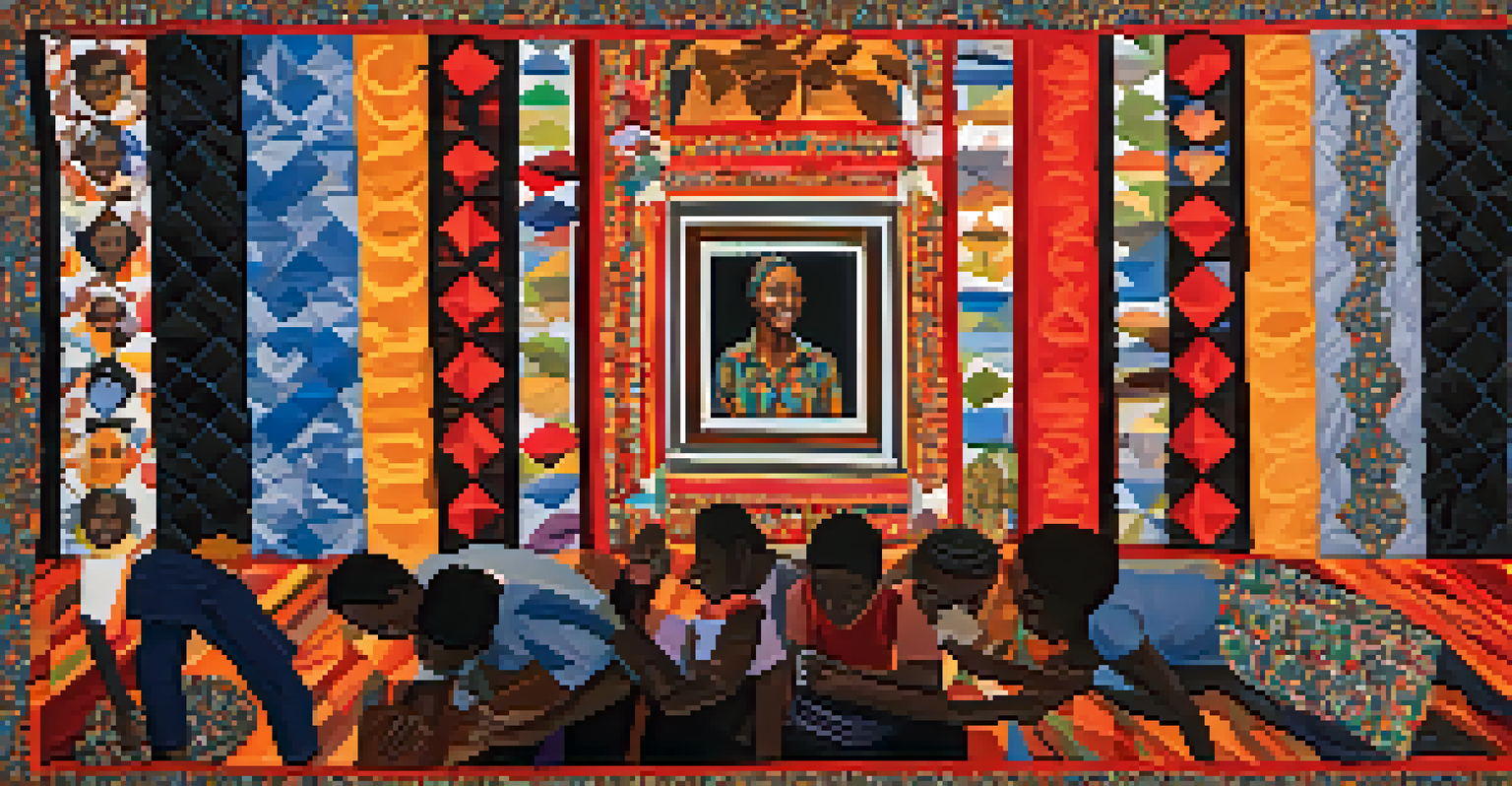Influential New Jersey Artists Who Shaped American Art

The Legacy of Paul Robeson: Singer and Activist
Paul Robeson was not just a celebrated singer and actor; he was also a powerful activist whose work resonated deeply in American culture. His performances broke racial barriers and inspired many to fight for civil rights, making him a pivotal figure in both art and social justice. Robeson's voice carried not only the weight of his talent but also the urgency of his message, echoing through the halls of history.
Art is a way of survival.
Born in Princeton, New Jersey, Robeson used his platform to advocate for the oppressed, becoming a symbol of resilience. His famous rendition of 'Ol' Man River' highlighted the struggles of African Americans, blending art with activism in a way that few had done before. This duality of purpose solidified his role as a transformative figure in American art and culture.
Robeson's impact extends beyond music and acting; he challenged societal norms and inspired future generations of artists to use their voices for change. His legacy reminds us that art can be a powerful tool for advocacy, encouraging others to follow in his footsteps and embrace the responsibility that comes with creativity.
Georgia O'Keeffe: The Pioneer of Modern American Art
While often associated with New Mexico, Georgia O'Keeffe's roots trace back to Sun Prairie, Wisconsin, and her artistic journey took shape in New Jersey. Known for her large-scale flower paintings and striking landscapes, O'Keeffe's work redefined how American art was perceived. Her unique style emphasized bold colors and organic forms, allowing viewers to see beauty in the ordinary.

O'Keeffe's time in New Jersey was marked by her exploration of the natural world, which profoundly influenced her artistic vision. The state's landscapes served as a backdrop for her early works, setting the stage for her later masterpieces. This connection to her surroundings illustrates how place can shape an artist's identity and output.
Art as a Tool for Activism
Paul Robeson's legacy exemplifies how art can break barriers and advocate for social justice.
Her contributions to American art cannot be overstated, as she paved the way for female artists in a male-dominated field. O'Keeffe's legacy continues to inspire countless individuals, emphasizing the importance of personal expression and the beauty found in nature.
Richard Diebenkorn: A Master of Color and Form
Richard Diebenkorn, born in Portland, Oregon, spent significant time in New Jersey, where he developed his signature style that would earn him recognition in the art world. Known for his abstract landscapes and figurative paintings, Diebenkorn's work reflects a keen awareness of color, light, and composition. His unique approach helped bridge the gap between abstraction and realism, making a lasting impact on contemporary art.
The artist must be a philosopher; the philosopher must be an artist.
Diebenkorn's time in New Jersey allowed him to experiment with different techniques and perspectives, enriching his artistic vocabulary. His works invite viewers to engage with the complexities of space and color, offering a fresh perspective on the everyday world. This exploration showcases how artists can evolve through their experiences in various locations.
As a prominent figure in the California art scene, Diebenkorn's roots in New Jersey remind us that the influence of place is vital in shaping an artist's voice. His legacy serves as a testament to the power of exploration and innovation in the ever-evolving landscape of American art.
The Abstract Expressionism of Joan Mitchell
Joan Mitchell was a leading figure in the Abstract Expressionist movement, known for her vibrant and emotive paintings. Though born in Chicago, her time spent in New Jersey greatly impacted her artistic development, allowing her to engage with the natural environment that inspired much of her work. Mitchell's canvases, filled with dynamic brush strokes and bold colors, convey deep emotional resonance, inviting viewers into her world.
Her connection to the landscapes of New Jersey can be seen in the way she captured the essence of nature through abstraction. Each stroke and color choice reflects her feelings and experiences, transforming the canvas into a window to her soul. This ability to translate emotion into visual language highlights the significance of personal experience in art.
Influence of Place on Artists
Many artists, like Georgia O'Keeffe and Richard Diebenkorn, draw inspiration from their surroundings, showing how locale shapes creative expression.
Mitchell's contributions to American art extend beyond her paintings; she was a trailblazer for women in the arts, breaking barriers and paving the way for future generations. Her legacy serves as an inspiration, reminding us that art can be a profound expression of identity and emotion.
The Cultural Impact of Romare Bearden
Romare Bearden, a prominent African American artist, was known for his groundbreaking collages that reflected the African American experience. Though he spent much of his life in New York, Bearden's connections to New Jersey played a crucial role in shaping his artistic narrative. His work often depicted the struggles and joys of Black life, making powerful statements about culture and identity.
Bearden's innovative use of collage—combining photographs, fabric, and painted elements—transformed the way stories could be told through art. His unique approach allowed him to weave together various cultural influences, creating a rich tapestry of narratives that resonated deeply with audiences. This blending of mediums showcases the power of creativity in expressing complex ideas.
Through his art, Bearden challenged societal perceptions and highlighted the beauty within the African American community. His influence continues to be felt today, inspiring artists to use their work as a platform for storytelling and social commentary.
The Visionary Works of Faith Ringgold
Faith Ringgold is celebrated for her vibrant storytelling through quilts and paintings, often addressing issues of race and gender. Growing up in Harlem, her experiences were further enriched by her time in New Jersey, where she developed her unique artistic voice. Ringgold's work combines elements of folk art and contemporary themes, making her a standout figure in the art world.
Her quilts, often narrative-based, serve as a way to preserve and share African American history. Each piece is not only a visual delight but also a poignant commentary on social issues, inviting viewers to engage with the stories woven into the fabric. This approach underscores the importance of art as a medium for preserving cultural narratives.
Legacy of Storytelling in Art
Artists such as Faith Ringgold and Romare Bearden use their work to narrate cultural histories and address social issues, emphasizing the power of storytelling.
Ringgold's influence extends beyond her art; she is an advocate for social justice and education in the arts. Her legacy encourages artists to use their platforms for advocacy, demonstrating how creativity can inspire change and foster understanding across communities.
Maya Lin: Designing Spaces with Purpose
Maya Lin, best known for her design of the Vietnam Veterans Memorial, has made significant contributions to both art and architecture. Although she was born in Ohio, her educational journey in New Jersey helped shape her vision for creating spaces that resonate with meaning. Lin's work often reflects her deep connection to the environment, emphasizing the relationship between nature and human experiences.
Her approach to design is rooted in the idea of creating spaces that evoke emotion and contemplation. The Vietnam Veterans Memorial, for instance, serves not only as a tribute but also as a place for reflection, allowing visitors to connect with history in a profound way. This emphasis on purpose in art highlights how design can influence our interactions with the world.

Lin's contributions extend into environmental activism, as she advocates for sustainability and the preservation of natural spaces. Her legacy inspires future generations to consider the impact of their creations, reminding us that art and design can serve as powerful vehicles for change.
The Unforgettable Style of Peter Max
Peter Max is known for his psychedelic art that captures the spirit of the 1960s and 70s, with vibrant colors and whimsical themes. Born in Germany and raised in Brooklyn, his time in New Jersey played a significant role in shaping his artistic identity. Max's work reflects a fusion of pop culture and personal expression, making him a beloved figure in American art.
His iconic style, characterized by bold colors and playful imagery, resonates with audiences of all ages. Max's art often conveys messages of peace and love, aligning with the cultural movements of his time. This focus on positive themes illustrates how art can inspire hope and unity in society.
Max's influence continues to be felt in contemporary art, as he encourages artists to embrace their individuality and creativity. His legacy serves as a reminder that art can transcend boundaries, fostering a sense of connection and joy among people.